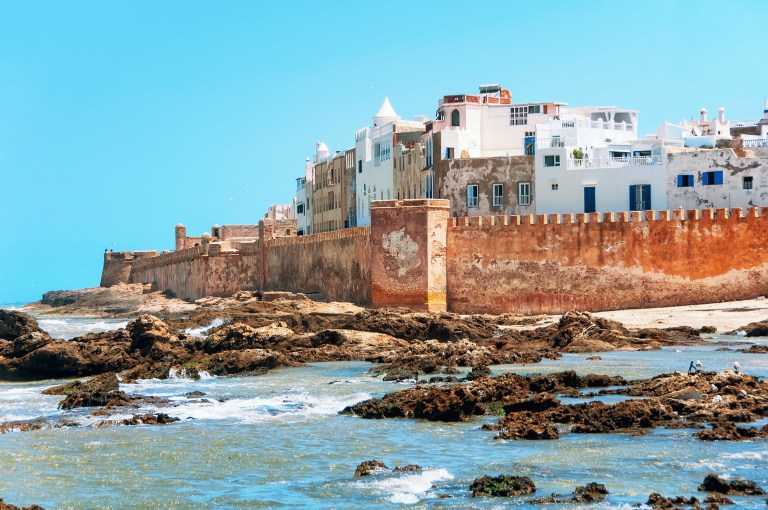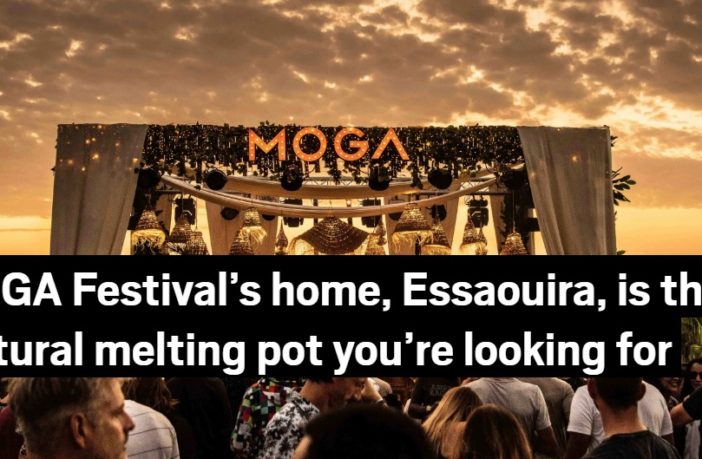Metro News
By Martin G Hewitt
It’s hard to convey the ambience of Morocco’s traditional gateway to South America without resorting to cliches.
The vast majority of travellers that wind up here— following in the footsteps of thousands that have wandered before them, not least Jimi Hendrix— will arrive via Marrakech. It takes some three hours drive to reach Essaouira, and the ocean, and the difference between the two cities couldn’t be more pronounced.
It’s also home to MOGA Festival, a weekend-long showcase of local, regional, African and international electronic artists, which emphasises its status as a hub of alternative culture. It’s the definition of an enchanting melting pot.

MOGA festival is set in Morocco’s traditional gateway to South America (Photo: Juliet Airs) The road to the Essaouira comes with endless vistas across open savannah; you’re far removed from Europe’s over-development. Make the journey at sunset and crimson haze dominates the skies overhead; a preview of the magic to come.
But there’s no pressure here, nor rush, despite having been on the tourist route for decades. You might be here for the music, not to mention the party that comes with it, but spending some time soaking up the town’s ambience is essential. All life greets you walking down any of the Medina’s packed streets.

Characters run the gamut from young, modern businessmen— wheeling and dealing on WhatsApp— to arched-backed old timers plucked from distant pantheons, faces half-hidden beneath traditional robes. The Skala de la Kasbah, ramparts that have long-protected the city from seafaring invaders and Mother Nature herself, are equally enchanting.
These stone walls are instantly recognisable as Astapor, one of the settings for the TV smash hit, A Game Of Thrones. Despite its links to the entertainment industry, Essaouira’s main role remains that of a working port and the base for a thriving fishing industry.
Down at the harbour you’ll find an armada of quaint blue boats moored each afternoon, having returned to shore, catch-of-the-day on board. It’s possible to commandeer a local to help strike deals with fishermen in the tile-floored indoor market, but thankfully you don’t have to chance on a helpful stranger to experience intoxicating flavours.
Nearby restaurants serve ultra fresh fruits of the sea, from grilled sardines to oysters. You’ll also find heavy sub-Saharan and, thanks to the colonial past, French influences without having to look very hard, alongside Arabic cuisine and Middle Eastern street food (shawarma is quite literally everywhere).
The pace of life might be slow, but that doesn’t mean every day has to be lackadaisical; head for dirt tracks and dunes beyond the city limits for high intensity action. I opted for high-speed quad bikes, hired through Diana Quad, and was guided through steeped corners, sudden twists, sharp turns and— best of the lot— a long stretch of empty beach for full-throttle action.
It is not to be missed. Essaouira couldn’t feel more removed from Marrakech’s rabid haggling, manic labyrinths and sensory overload. It has plenty of opportunities to barter, too, and the Medina— or historic centre— is a rabbit warren of narrow streets packed with smells and sights. Before heading to MOGA Festival itself the so-called Off programme is worth a punt.
From a photography exhibition at cultural centre Dar Souiri (where film screenings and concerts take place throughout the year) to design panels, these side attractions confirm how much the MOGA values aesthetics and artistry. Hence the look of the site-proper: spread throughout the grounds and interior of the high-class Sofitel, MOGA is living proof that Essaouira is a place where cultures collide.

Drafting in global DJs such as Kenny Dope, Blond:ish and Bradley Zero, and pairing these with 50% domestic talent, it’s a reminder for the global reach of dance music today.
A highlight of the festival was live act Parallels with homegrown Gnaoua (or Gnawa) music star Maâlem Omar Hayat— colloquially known, we are told, as the Jimi Hendrix of the sintir; a percussive-guitar instrument that’s as mesmerising as it is commanding live. Their set was a musical odyssey calling on tribal rhythms, house beats and ambient melodies.
Within the lavish setting comprising indoor club, outdoor pool stage (adorned with bedroom furnishings) and otherworldly gardens, you can also find the MOGA Souk selling crafts and products from local and national artisans. Against this backdrop the atmosphere is a combination of decadence, debauchery and stylish extravagance— a metaphor for both Essaouira and Morocco overall.
A destination where mysticism and modernism meet, where beauty is found in both the aesthetically overwhelming and the sparsest of views, a trip to Essaouira is up there with the most adventurous you could hope for on a weekend away from rainy England.







